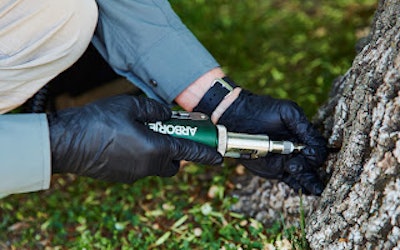
Just as humans rely on medicine to prevent future illness and heal from current ones, so too can trees require injection remedies.
Arborjet SE Regional Technical Manager and ISA Certified Arborist JB Toorish and Lisa McCoy, vice president of sales and operations at Mauget, explain.
What injections are
For trunk injection technology, control products are injected directly into the tree’s vascular tissue. This helps control pests and diseases and correct nutrient deficiencies like chlorosis. The injections are performed through a port that is placed behind the cambium and into the xylem tissue.
“The port acts as a one-way valve that moves the product directly into the vascular tissue and seals the product into the tree,” Toorish says. “The pressure from the injection remains behind the plug, which helps to move the product through the vascular system into the tree canopy. The port, when properly set, does not injure the tree; it actually aids in the compartmentalization process.”
Injections can be appropriate for any type of tree, but they are typically needed when tree is near water, in a sensitive area (such as a pool or parking lot) or in areas that are too large to spray. Trunk injection is generally the best choice when the tree is infected with a serious invasive pest that will eventually kill the tree if it’s left untreated. These pests can include emerald ash borer, pine bark beetle, hemlock woolly adelgid, palm weevil and lethal bronzing of palms.
Currently, there are several types of trunk injections that incorporate various equipment and techniques.
For example, macro infusion uses a large volume of product injected through root flares, micro infusion uses IV bottles and micro injection uses syringe-type applications. Caps or capsules are another technique that contain product attached directly to tree.
The main advantages of tree care injections, Toorish says, are efficacy, multiyear protection and direct delivery to the target pest.
McCoy adds that tree care injections provide the following benefits:
- No drift or off target chemical exposure to the environment
- No water contamination concerns
- No soil contamination or runoff
- “Closed” chemical application system
- Systemic application, active ingredient is inside the tree
- Less exposure for beneficial insects
- Efficient, targeted chemical application
- No mixing or loading
- Less active ingredient per acre means more plants treated when the amount of active ingredient is limited by law
- Small injection site
- No hardware left in the tree
- Excessive mulch does not affect application
“The chemical stays where it’s supposed to—in the tree,” McCoy says. “In addition, with restrictions on the amounts of materials that can be used per acre, more trees can be treated with a lower amount of pesticide.”
Toorish adds that appropriately timed applications pose no risk to beneficial predators and pollinators.
Following an injection, tree care professionals may want to perform quarterly or yearly inspections and follow up with periodic fertilization and soil amendments to enhance the overall health and vigor of the trees and plant material, according to Toorish.
“Offering other services in the program such as the use of plant growth regulators, pruning, root crown excavation and vertical mulching can also improve tree health and vigor,” Toorish says.
Education is key
Tree care professionals performing any kind of injection work should be equipped with the following personal protective equipment (PPE): long sleeves, gloves, eye protection, long pants, socks and shoes, McCoy says.
“You always want to wear PPE especially when using insecticides,” McCoy says. “We don't ever want anybody to get contaminated.”
Additionally, before tree care professionals decide to perform a tree injection, they need to be properly trained.
“We recommend that service providers get trained in how the methodology works and how to target pest problems,” Toorish says. “Learning how to set plugs, the number of plugs needed, placement of plugs and how different tree vascular systems function is essential for successful treatments.”
Some providers will offer training at no cost and provide hands-on demonstrations and online resources to help tree care professionals become comfortable with the technology.
In addition to educating themselves, tree care pros should also educate their customers on all plant care health options and notify them about what current pests are in the area so they can create a proactive approach.
“We recommend the integrated pest management (IPM) approach,” Toorish says. “IPM uses knowledge of pest and host biology in combination with biological and environmental monitoring to respond to pest problems with management tactics.
Looking ahead
Looking ahead, several tree care injection providers are looking to improve formulations so they are easier to use and lessen the impact on labor, Toorish says.
Granular products and battery-powered tree injection devices may help fill these gaps.
Chainsaw Talk
For this, tree care professionals will use other tools as well, such as chainsaws. Jake Teitler, senior manager of product marketing at Milwaukee Tool, provides a few maintenance tips when using this type of equipment.
“Ensuring a chainsaw is maintained properly can be critical to the safety of its operation in application and the efficiency of its operator,” Teitler says.
When using gas solutions, operators should be sure to replace spark plugs, recoil starters, air filters and carburetors leading to frequent engine maintenance which can impact a saws’ performance. Battery-operated equipment, on the other hands, requires no engine maintenance.
However, when using battery-powered tree care solutions, landscape crews should develop charging routines that ensure they can carry out their work without disruptions caused by a lack of charged batteries or sacrificing safety.
“Whether overnight charging routines are preferred or there is access to daytime charging throughout the workday, these practices can significantly impact a crew's workflow and their ability to meet productivity needs,” Toorish says.
Outside the Box, Inside the Lines
As many tree care pros know, efficiency is key on tight, compact jobsites.
“To further complicate matters, these jobsites often require extra care not to damage a homeowner’s lawn, existing landscaping or hardscape structures,” says Brant Kukuk, product manager at Ditch Witch. “Here, operators need to be aware of a variety of issues that can cause costly downtime as well as equipment or property damage. With their maneuverability and narrow and compact design, stand-on skid-steers allow tree care professionals the ability to maneuver around obstacles and through fence gates with ease."
Below are advantages of using skid-steers on a jobsite, according to Kukuk:
- Increased visibility: A stand-on skid-steer gives operators an unobstructed, 360-degree view of the jobsite. The absence of a cab significantly enhances visibility. This increased visibility is crucial for preventing accidents and ensuring precise operation. Additionally, the quick hop-on, hop-off capability of stand-on skid-steers facilitates seamless task transitions, improving overall productivity. With the simplicity of the easy-on, easy-off platform, the operator can transition as needed between helping the cutter with his or her responsibilities and operating the machine.
- Variety of attachments: Whether operators are looking to make fewer cuts, auger a hole or install a new tree, stand-on machines have at least 10 interchangeable attachments that are beneficial to tree-care-related tasks. Each of these attachments is easily fitted onto a machine, allowing tree care professionals to quickly switch in the field. This simplicity and versatility means that tree care professionals only need to bring one machine to a jobsite.
Before deciding to use a skid-steer on a jobsite, Kukuk says operations must adhere to the following protocols:
- The size and weight of a stand-on skid-steer must be appropriately matched with the attachments being used to ensure stability and safety. The machine must have sufficient counterbalancing capacity to handle the load of the attachment.
- When working with attachments, the standard rule of thumb is that an operator should have three industry-specific attachments in their arsenal. For example, a tree care professional might have a grapple, bucket and stump grinder to help complete a variety of tree care-related tasks.
- Contractors should always consult their local dealers. They are a vital resource for questions surrounding jobsite conditions, local regulations and industry insights. Visiting a local dealer allows contractors to test out equipment and work with the dealer to ensure they make a well-informed decision.














![Doosan Bobcat Wacker Neuson Stack 2ec Js Pb V6e[1]](https://img.greenindustrypros.com/mindful/acbm/workspaces/default/uploads/2025/12/doosan-bobcat-wacker-neuson-stack2ecjspbv6e1.CPyyz8ubHn.png?ar=16%3A9&auto=format%2Ccompress&bg=fff&fill-color=fff&fit=fill&h=135&q=70&w=240)




